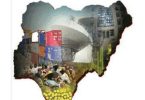Ever-busy, hustling, and bustling with a high pitch; the city that literally NEVER sleeps. Lagos is quite unlike any other city in Nigeria, even Africa at large. Presently the largest West African city and the commercial capital of Nigeria, Lagos is also reputed to be the third largest city in Africa. And the population is increasing every day; nearing 16 million as of 2023 – a mixed blessing.
The ascendance of Lagos to its present cosmopolitan status started as far back as 1900, under the command of the British officer, Lord Lugard. The prime location of Lagos as a major West African port fringing the coasts of the Atlantic Ocean could not be ignored. It went beyond being a major entry point for European settlers, to progressively becoming a huge trade center.
The History of Lagos
‘Lagos’ (Portuguese word for ‘lakes’) acquired its name from Portuguese explorers, the very first Europeans that arrived on its shores in 1472. At the time, the Awori tribe of Yorubaland occupied the territory and farmed the land (around the late 15th Century). As such it was called ‘Oko’ or ‘Eko’ (farm). Notable Awori settlements at the time included both Iddo and the larger Lagos Island. Amongst these people were not only farmers, but fishermen and hunters. The native name ‘Eko’ officially became recognized by visitors and dwellers.
From the 16th to the mid-19th Century, warriors from Bini kingdom arrived in ‘Eko’ and formed training camps. Thus the entire area fell under the control of the Oba of Benin. However, for a brief while, Eko was subjected to the control of Oyo Empire in the early 19th Century.
The locals carried out their trade (especially in clothes) along the coast of Lagos; it advanced slowly for about a century. The local rulers (Obas) also gradually built a good rapport with the Portuguese, who initially referred to the area as ‘Onim’ (and later ‘Lagos’). But between the 16th and 18th Centuries, the Portuguese traders acquired trade monopolies (from the Spanish crown). It was to the effect of being able to acquire and sell African slaves in Spanish America. That of course was with the consent and cooperation of the local Obas. Thus a booming transatlantic Slave trade was established.
Over time, influential African ex-slaves in the British homeland called for the end of slave trade. Oba Akintoye of Lagos had also been deposed and exiled to Europe by local merchants and subjects, in his attempt to ban slave trade. Thus the British government intervened – leading to the naval attack on Lagos in 1851. The reigning monarch of Lagos at the time, Kosoko (Akintoye’s brother) was thereby dethroned; and Akintoye was reinstalled. Akintoye proceeded to sign a treaty with Britain for the abolishment of slavery in 1852, thus securing military protection for Lagos. However, neither the naval attack nor dethronement succeded in stopping the slave trade. It continued until the British took full control of Lagos in 1861 when Oba Dosunmu was mandated to sign the Lagos Treaty of Cession.
Lagos was thus declared a British Colony in 1862 under the control of the Gold Coast (Ghana). By 1886, Lagos became an independent colony. Over time, returnee ex-slaves (‘Creoles’) arrived from Brazil, Sierra Leone, and the West Indies on the shores of Lagos in the 19th Century. The Creoles were largely responsible for the modernization of Lagos, bringing with them their knowledge of Portuguese architecture. A typical example is the Cathedral of Church of Christ, built in 1869. Thus Lagos became an important import/export, trade, and immigration port for both Africans and Europeans.
The Emergence of Lagos as Capital City
Around 1900, Lord Frederick Lugard arrived in Lagos, then later relocated with his troops into Northern Nigeria. Lugard appointed Lagos as the capital of the Protectorate of Southern Nigeria in 1906. But by 1914, both the Northern Protectorate and Southern Protectorate were unified into the Colony and Protectorate of Nigeria by Lord Lugard. Lagos was again appointed its capital city. Lagos enjoyed the status of the federal capital city up until 1991 – when the federal capital was moved to Abuja. Nevertheless, Lagos remained the commercial nerve center of Nigeria.
However, Northern Nigeria was controlled by local rulers through the system of ‘Indirect Rule’. While the South was directly controlled and influenced by the British government. Which meant that the traditional rulership systems of the North remained intact. However, the South was supplanted with determination by the British system of governance.
Modernization of Lagos
The infrastructural development of Lagos advanced under British rule. Between 1896 and 1901, the Lagos Government Railway constructed a railway line from Lagos to Ibadan. The railway was subsequently extended to pass through Osogbo, Ilorin, Kaduna, Zaria, and Kano ending at Nguru. By 1886, telephone cables were laid, connecting Lagos to London. In 1898, the electrification of Lagos was achieved. In 1901, the Carter Bridge was built (the first ever bridge built in Lagos) to connect Lagos Island to the Mainland. The Lagos Port was officially commissioned in 1913.
In 1914, a steamer mailboat service that ran regularly (once a month) from Lagos to Liverpool (Britain) began. The steamer boat carried letters, cargo, and passengers; making a brief stop-over at Liberia, Sierra Leone, Gambia, and Gold Coast (Ghana) on its trip. Following this, air transportation commenced in Lagos in the year 1945. Further extension of the railway network across the Niger and Benue rivers continued thereafter.
All the infrastructural development, education of the locals, and training of skilled and semi-skilled workers (especially to service the railways) helped Lagos to develop rapidly. Its development has continued till the present day, though not without attendant town planning headaches.
Lagos: Its Features and Challenges of Urban Planning
Lagos is well known for its lagoons, sandbars, and islands. There have been efforts to reclaim more lands through sandfilling, in order to extend the major islands (especially Victoria Island and Lekki). There is also a fairly well-developed road network and a network of bridges connecting different parts of Lagos. Lagos Island and Ikeja (the state capital) are particularly noted for their many high-rise buildings. Additionally, there are a vast number of manufacturing industries and service providers of all kinds in Lagos. Lagos welcomes the rich and poor, the influential ones, and the common man.
Aside from this, Lagos remains a major center for both sea and air travel (namely Apapa Quay and Murtala Mohammed Airport). It is also a major fishing, trade, education, entertainment, and tourism hub. You will find the best hotels and restaurants, public and private schools, finance houses, entertainment centers, and opportunities for entrepreneurship in Lagos.
However, there are notable problems of overcrowding, poor/ignored town planning, and poor urban control. This has led to many narrow streets, problematic drainages, frequent traffic gridlocks, and inefficient housing designs. It has also led to the proliferation of slums, polluted environment, as well as illegal operations of area thugs (‘Omo Onile’). Again, aside from the existing problem of innumerable rural dwellers constantly trooping to Lagos to seek greener pastures, there is a humanitarian crisis. Hundreds of internally displaced persons have come from further North to settle indiscriminately around Lagos (especially in mainland slum areas). Agege, Ajegunle, Mushin, and Okokomaiko are just a few of such troubled settlements. This has further worsened the environmental pollution woes of Lagos.
The town planning problems of Lagos began when Nigeria fell under Military rule (from 1966 to 1979; and from 1984 to 1999). Both the federal and state capitals (Ikoyi and Ikeja) occupied the same state during the first military regime, beginning in 1966. It was believed to have put more pressure on the state. Aside from this, the military rulers demonstrated little or no sense of responsibility towards the maintenance of Lagos and its environment. Lagos was simply left to its own devices without any supervision, control, or maintenance; and so things quickly went downhill. Much of the public infrastructure has been ignored for too long and needs to be attended to. Especially potable water supply and waste disposal.
However, recent developments show that the state government is determined to upgrade and maintain the public infrastructure of Lagos, thus reducing the chaos. More roads are being maintained; with street lights, surveillance cameras, traffic control lights, and law enforcement cum road safety officers on standby. It has helped to reduce the number of road accidents and traffic congestion in recent times. Again, Lagos now has the BRT (Bus Rapid Mass Transit) system in place and is developing a multi-phase railway network (including electrified railroads). Finally, the state government has also entered into consultations with CDAs (Community Development Associations). This is with the aim to improve security and other basic infrastructure, such as drainages.








